160 Years of Irish and Continental Trading

 A British coastal liner shipping company that traded continuously for 160 years from its foundation in 1821 calls for great acclaim and respect. The company was founded by eight British merchants from Bristol, with the mundane title of the War Office Steam Packet Company to carry out a War Office contract to Ireland for the carriage of troops, recruits and convicts. Great skill was needed from the early Masters of the ships e.g. George Bailey, John Hyde, John Finlayson and William Rees, and their crews to keep well off lee shores, and to avoid, in the days before radar, the frequent collisions that relegated most ships to having brief careers of only a few years. The first company base was at Hotwells on the ‘Floating Harbour’, with its area bounded by the ‘Floating Harbour’, Limekiln Glass House to the east, and the Albion shipyard of the Hillhouse family to the west. Charles Hill began work at the yard in 1810 and became manager in 1822 and partner in 1825, with the yard renamed as Hillhouse & Hill in 1840 and Charles Hill & Sons in 1845. He and his family were to complete many ships for the company, with the two businesses working well as neighbours.
A British coastal liner shipping company that traded continuously for 160 years from its foundation in 1821 calls for great acclaim and respect. The company was founded by eight British merchants from Bristol, with the mundane title of the War Office Steam Packet Company to carry out a War Office contract to Ireland for the carriage of troops, recruits and convicts. Great skill was needed from the early Masters of the ships e.g. George Bailey, John Hyde, John Finlayson and William Rees, and their crews to keep well off lee shores, and to avoid, in the days before radar, the frequent collisions that relegated most ships to having brief careers of only a few years. The first company base was at Hotwells on the ‘Floating Harbour’, with its area bounded by the ‘Floating Harbour’, Limekiln Glass House to the east, and the Albion shipyard of the Hillhouse family to the west. Charles Hill began work at the yard in 1810 and became manager in 1822 and partner in 1825, with the yard renamed as Hillhouse & Hill in 1840 and Charles Hill & Sons in 1845. He and his family were to complete many ships for the company, with the two businesses working well as neighbours.
Bristol And The Early Steamers Of The Company
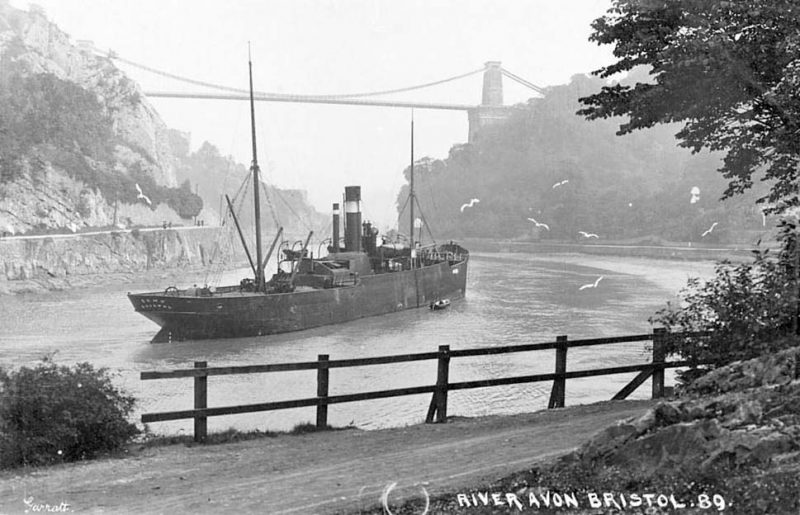
The Avon river was a trading and shipping point in Roman times, and by the 1600s shipping had moved upriver to Bristol to the confluence of the Avon and Frome rivers. The great tidal ranges meant that shipping at Bristol had to ‘take the ground’ at low water. This situation remained until 1803 when the ‘Floating Harbour’ was constructed by diverting the course of the Avon along a new channel, the New Cut, which when filled with water allowed a harbour unaffected by tides. Imports to the ‘Floating Harbour’ included cotton, tobacco, rum, cocoa and sugar, while grain and wool was exported.
The Bristol Steam Navigation Company owned only steamers from its inception in 1821, and in this respect matched its great competitor, the General Steam Navigation Company of London. Two small steamers were ordered for completion in 1822/23 for a Bristol to Cork and Dublin service, and began the company service as George IV of 136 grt and Palmerston of 115 grt with hull lengths of around 110 feet. Competition was intense with the St. George’s Steam Packet Company of Liverpool, formed by businessmen from Liverpool, Cork and Dublin, that had started their Bristol to Dublin services in May 1822, a year before the Bristol based company. Thus, a Bristol to Waterford and Cork service was also tried by the Bristol based company, with an outward call at Tenby and a homeward call at Milford Haven. The Bristol to Cork link by the St. George company began briefly in 1823 and restarted again in 1826 in direct competition with the Bristol company. The St. George company was restructured in 1843 to become the City of Cork Steam Ship Company for Liverpool to Cork services, and thus relieved the competition with the Bristol company.
In 1827, when the War Office contract expired, the company changed its name to the General Steam Packet Company, and again in 1834 to the Bristol Steam Packet Company, and was restructured on 23rd August 1836 with new shareholders as the Bristol General Steam Navigation Company. The office, with warehouse and lofts behind, at Princes Street was rented from the Corporation of Bristol for forty years, renewable afterwards every fourteen years. Five steamers of this era were built for the Bristol company at Hotwells in City of Bristol (1828 of 209 grt), City of Waterford (1829 of 271 grt), Killarney (1830 of 273 grt), Albion (1831 of 250 grt), and Osprey (1835 of 229 grt). They had hull lengths of around 150 feet, beam of 25 feet, a single deck with fo’c’stle, bridge and poop, and had two masts, a schooner rig, square sterns, quarter deck galleries, and half figureheads. Osprey was a fast ship, routinely making the Bristol to Waterford run in seventeen hours, and the Bristol to Dublin run in 21 hours. She was converted to ship rig in 1853 and sold for service in Australia.
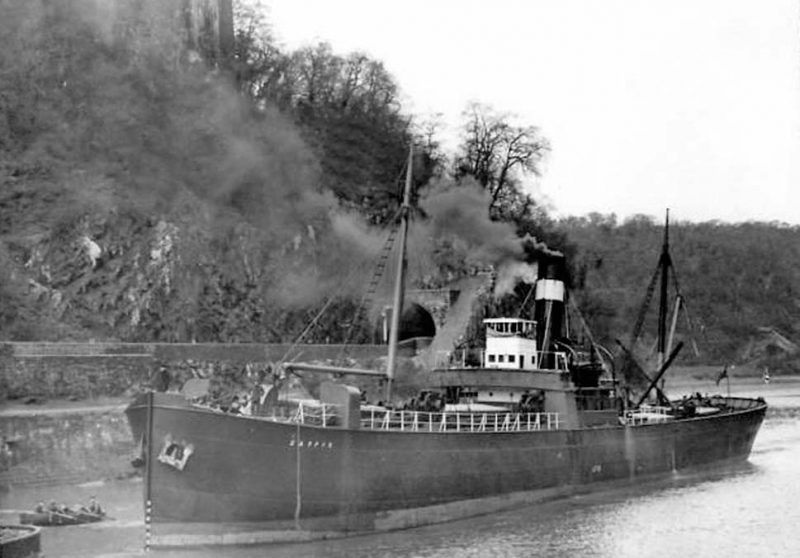
The schooner rigged paddle steamer Frolic, owned by the company, was on a regular voyage on 17th March 1831 from Haverfordwest to Bristol when she struck the Nash Sands in Glamorgan with the loss of all eighty passengers and crew including General MacLeod and several Army officers and Pembrokeshire merchants. It was as a result of the outcry following this terrible disaster that Trinity House provided two lighthouses in 1832 to mark the safe channel between the sands and the mainland.
City of Waterford was wrecked on 22nd September 1833 in fog near Peniche in Portugal while on a charter to Lisbon, fortunately all her crew were saved. Killarney of 273 grt was wrecked on 19th January 1838 after sailing from Cork and reaching Poor Head, but heavy weather forced her back to Cork. She sailed again later the same day but was thrown on her beam ends and then driven onto the Rennie rocks. The Master and thirteen others from her crew were saved, including Charles Goodland who sailed on six company ships between 1836 and 1853. Four other company ships were wrecked between 1837 and 1840, including City of Bristol when she sailed from Waterford to Bristol on 17th November 1840, but she was wrecked the following day when she ran aground in a violent storm near Worm’s Head. Thirty four lives were lost including Capt. Stacey, with one of the three survivors dying soon after landing.
Thus, a new fleet was needed, and paddle and screw driven coastal vessels were built e.g. Rose of 1842 built by Lunell in Bristol in 1842, Taff of 1841, Swift of 1844, Juno of 1853, Calypso of 1855 from a Clyde yard, Apollo of 1862 from Caird of Greenock, Briton of 1862 from the Clyde, Alfred of 1864, the famous twin funnelled Juno (2) of 1868 from the London and Glasgow Shipbuilding yard followed by Argo from the same yard in 1871, Sappho of 1869 from the Elder yard on the Clyde, Constance from the Inglis yard on the Clyde in December 1871 and acquired in 1873, and Clio in February 1873 from Key of Kinghorn on the north east coast of Scotland. The lengths of these steamers ranged from 200 feet to 270 feet with beams from 25 to 30 feet, and they were powered by two cylinder compound steam engines. Argo had her engines almost aft, more ‘three quarters’ aft, and sailed on the Dublin passenger run until 1908.
The company was one of seventeen steamship companies that presented petitions against the 1853 Bill in Parliament to give the South Eastern Railway the right to run steamboats between ports in Kent and those in France. The two year old twin funnelled wooden paddle tug Atlas of 100 grt, built by Charles Hill and Sons Ltd. at Hotwells, was purchased in 1856 to ease the passage of company ships through the ‘Floating Bridge’ to the various company berths further upstream.
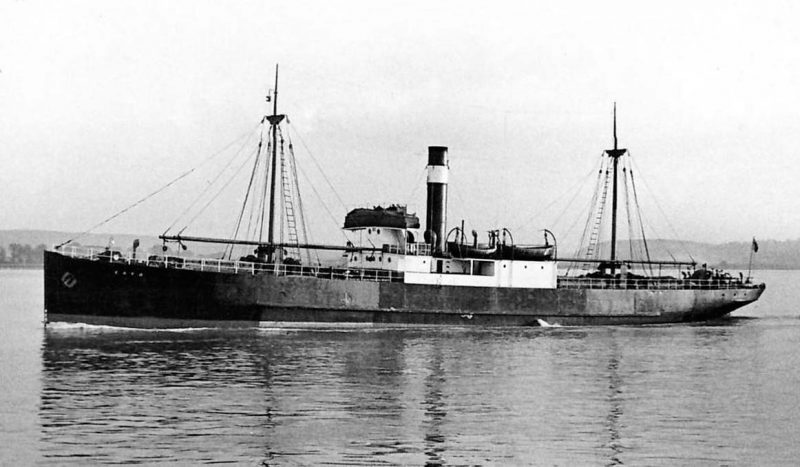
Paddle steamers were preferred for the faster passenger services to Ireland, including Briton (1862), which was lengthened in 1876 and retired in 1890, and Juno (2) of 1868, which had a passenger certificate for 650 and closed out the Waterford service in 1900. The Clyde built screw steamer Corsica of 1,581 grt joined the fleet in 1879, having been built for the Mediterranean service of Cunard Line in 1863 by J. & G. Thomson of Glasgow. She was lengthened in 1879 by Austin of Sunderland with dimensions of length 272.7 feet, beam of 32.7 feet and depth of 23.8 feet and re-engined with compound steam engines built by the Wallsend Slipway Company. She was deleted from the register in 1888.
In 1877, the company was sold to Cork interests of Sir John Arnott (1814-1898), who had been born in Fife and arrived in Cork in 1837 and later opened a large chain of drapery stores across Ireland and Britain. He was elected Mayor of Cork three times, and was also a director of the City of Cork Steamship Company. The title of the Bristol company was changed to the now familiar Bristol Steam Navigation Company in 1877. The company now ran Continental sailings from Bristol to Bordeaux from 1863, to Antwerp from 1871, and shortly afterwards to Hamburg, Amsterdam, Rotterdam and Baltic ports. The fleet had increased to ten steamers in 1880 as the Irish services began to decline in importance while the Continental services increased.
Larger steamers were purchased in the early 1880s, including the iron screw steamer Clifton 2,665/64 from the Smith & Roger yard in Glasgow, the iron screw steamer Bertha 2,207/71 from the Sunderland yard of T. R. Oswald, along with Nigel 1,362/82 (later renamed Juno) from Robert Steele & Sons of Greenock, whose yard was purchased by Scotts’ of Greenock in 1883. The twin funnelled London and North Western passenger paddle steamer Countess of Erne of 825 grt and built at Dublin in 1868 with accommodation for 728 passengers in two classes was purchased at auction in February 1889 at Liverpool and used for eighteen months as a storage hulk at their Brandon yard in Bristol. She had a subsequent long career of 67 years as a coal hulk before finally sinking in Portland harbour on 16th September 1935 in a fierce gale.
The first company vessel built with a steel hull was Dido of 674 grt and completed in September 1884 by Dobson & Charles of Grangemouth, having been launched as Azorian and purchased on completion. The company office had by now been moved to 33, Prince Street in Bristol, and it began to commission a long line of steamers from the Campbeltown Shipbuilding Company. This yard launched ships directly into Campbeltown Lough, a few miles north of the Mull of Kintyre on the Kintyre peninsula. The quarterdeck sisters Silvio, Cato and Ino of 1,240 grt were completed in 1889 with dimensions of length 230.0 feet, beam of 32.8 feet and depth of 15.0 feet, with triple expansion steam engines by Hutson & Sons of Glasgow. The Campbeltown yard then completed Ino(2) in October 1899 on the same dimensions, Milo in 1903 and ten feet longer, and the larger sisters Hero in June 1903, Tasso in October 1904, and Apollo in June 1906 on dimensions of length 273.0 feet, beam of 40.0 feet and depth of 19.3 feet. These later Campbeltown built steamers were of 1,870 grt, engines ‘midships steamers with a fo’c’stle of length 32 feet, a bridge deck of length 72 feet and a poop of length 40 feet.
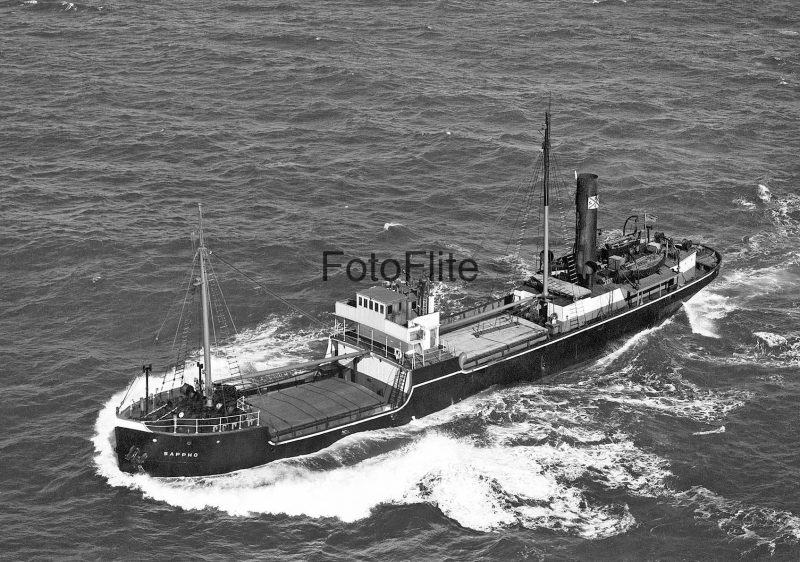
Collisions, strandings and accidents to company vessels continued in the 1880s and 1890s, with the iron screw steamer Constance built in 1871 aground off Plymouth in fog on 21st January 1888 while on a voyage from Rotterdam to Plymouth and Bristol. She slipped off the rocks and sank with the loss of three crew members. She had been launched on 9th December 1871 by A. & J. Inglis at their Pointhouse yard and was purchased for £16,000 by the Bristol Steam Navigation Company in 1873 for their Continental service to Antwerp, Amsterdam and Rotterdam, returning via Plymouth. She sailed from Antwerp on 19th January 1888 with a cargo of hides, zinc spelter, cases of wine glasses, casks of oil and sixteen tonnes of iron girders. It was dark and foggy when she arrived off Plymouth, but due to poor navigation by Capt. Henry Holt and Mate James Callaway she ran aground on the Shagstone outside the main channel at Wembury and became a total loss.
Calypso was on a voyage from Antwerp to Gloucester in November 1890 when she sheltered off a lee shore at Dungeness in thick fog. She was later rammed by the Spanish steamer Pinzon and had to be beached at Dungeness, and she was then towed off by the tug Zeelander and towed stern first to Dover. However, before arrival at Dover, Calypso began to sink with the Sandgate lifeboat called in to take off her crew just before she sank. The newly built Cato from the Campbeltown yard made only one voyage for the company, as she sank on her second voyage off the north coast of Cornwall after encountering heavy weather on 7th April 1899, unfortunately with the loss of eight lives. She was on a voyage from Cardiff to Hamburg with coal and general cargo, and the subsequent Board of Trade enquiry cleared her Master of any responsibility for her loss.
New Century and the Lovell Family
The ten company steamers owned in 1900 now had mostly names ending in ‘o’ e.g. Argo, Clio, Echo, Pluto, Silvio and Sappho. The company had a new business partner since 1896 in Charles Shaw Lovell, who came from a Bristol family, and had begun as a ‘Shipping and Forwarding Agent’ in 1869 at a wharf at Greenwich riverside near to where the Cutty Sark is permanently berthed in dry-dock today. He had a London office in Gracechurch Street, an address he shared with the London office of the Bristol Steam Navigation Company. He was soon instrumental in the Bristol Steam Navigation Company purchasing the Gloucester Steamship Company, and then received almost one quarter of the Bristol Steam Navigation Company shares. Lovell brought to the table a commission from the Great Western Railway, which the company expedited until the nationalisation of the railways in 1947. Egerton C. Lovell, the son of Charles, became a director of the company in 1901 whilst still in his twenties and later became Chairman of the company after the Arnott family relinquished control in 1947. Three other members of the Lovell family were also directors.
Passenger services to Ireland were terminated in 1914 due to competition with the Great Western Railway at Fishguard, those to Cork having been terminated in 1900. The company had a good sized fleet of twelve steamers in 1914, all now with names ending in ‘o’ in Apollo, Argo, Cato, Clio, Echo, Hero, Ino, Juno, Milo, Pluto, Sappho and Tasso. Argo 1,720/82, built by the William Gray yard at West Hartlepool, had been purchased from the Cork Steamship Company as Moorhen in 1910 and renamed. Three company ships were lost as a result of enemy action during World War I.
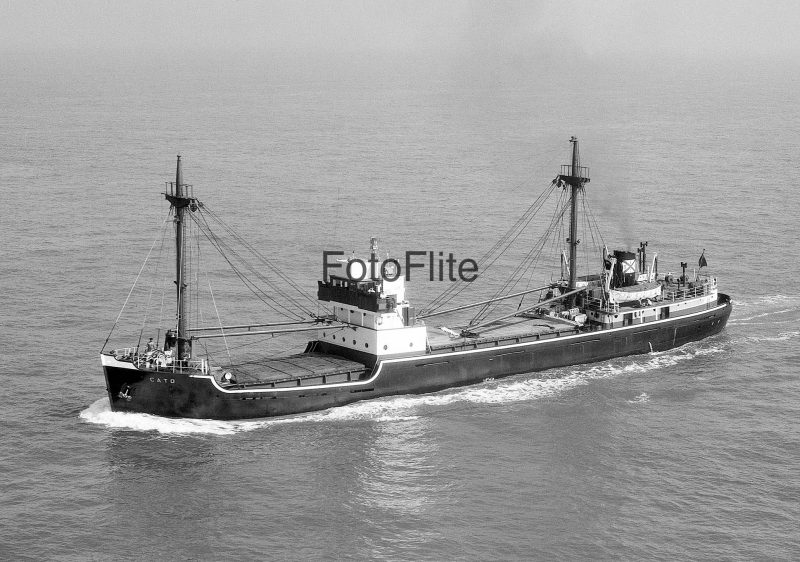
These were:-
- Argo mined and sunk in the English Channel on 8th February 1916 4.5 miles north west of Boulogne Pier while on a voyage from Boulogne to Dunkirk with a cargo of plywood, one crew member lost.
- Pluto torpedoed and sunk on 10th April 1917 32 miles ESE of Lowestoft by UB20 while on a voyage from Rotterdam to Bristol with general cargo.
- Juno ex Nigel torpedoed and sunk on 2nd May 1917 in the English Channel 17 miles from Cape Barfleur by UB18 while on a voyage from Rouen to Cardiff in ballast, one crew member lost.
- Sappho was the last vessel to leave Gloucester Docks before war was declared, and she arrived in Hamburg on the day of the outbreak of the war, and was interned and used as a collier by the German armed forces until returned at the end of hostilities. The crew became prisoners of war and were not released until after the Armistice was signed. Cato completed in June 1914 was requisitioned as a mine carrier throughout the war, and Tasso, Apollo, Clio and Milo were sent out to the Gallipoli campaign in the Dardanelles and were then sold, leaving only four ships in the fleet in November 1918 at the end of the war.
The Inter-War Years
In 1920, the company had four steamers employed on regular liner services from Bristol and Swansea and calling at Plymouth to Antwerp, Amsterdam and Rotterdam with Willem H. Muller & Company the loading agents at Amsterdam and Rotterdam. There was also a cargo only service from Bristol to Dublin, giving employment to one of the four steamers Cato of 1914, Echo of 1891, Ino of 1899 and Sappho of 1900. Sir John Arnott was Chairman of the company, with three other directors in Egerton C. Lovell, William Langlands of the coastal passenger liner company M. Langlands and Sons with Glasgow based services, which had been taken over by Coast Lines in September 1919, and William C. Beloe of Bristol.
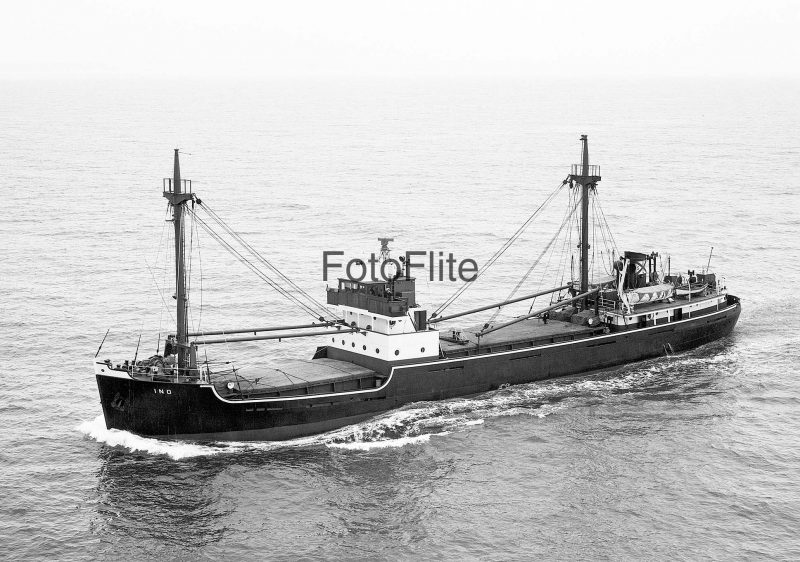
Echo collided with the Portuguese vessel Coimbra, owned by Sociedade Geral de Comercio Industria y Transportes, on 26th February 1923 in fog off Terschelling and sank while on a voyage from Hamburg to Bristol, reducing the fleet to three ships. The company vessels now loaded and discharged at Bathurst Wharf at ‘G’ shed and ‘M’ shed, which housed temporarily bacon, potatoes, beef, butter and Guinness stout from Dublin. ‘M’ shed, opposite the company office by the Swing Bridge, continued in use by the company throughout the 1950s for the twice weekly service to Dublin, before closure and then reopened its doors in 1977 as an Industrial Museum, later devoted to the living history of Bristol.
The fleet remained at three ships of Cato of 1914, Ino of 1899 and Sappho of 1900 during the six years of the Great Depression, increasing to four with the purchase of Alecto in 1936. The latter ship of 919 grt was built as Sir Walter Bacon by George Brown and Company of Greenock for the Bacon fleet in 1913 that was a constituent founder of Coast Lines, becoming Gloucester Coast until purchased by the Bristol Steam Navigation Company. Unfortunately, she was lost on 2nd May 1937 in collision in thick fog off the North Hinder Light Vessel with the Yugoslav vessel Plavnik while on a voyage from Swansea to Rotterdam, unfortunately with the loss of ten lives. Shortly afterwards, she was replaced by the purchased Kyleglen from Monroe Brothers of Liverpool, renamed as Melito. This coaster had been built by the Charles Hill and Sons yard at Bristol as Welsh Coast in 1915, and was then transferred to the British & Irish Steam Packet Company as Macroom in 1920, and then in 1922 to Coast Lines as Welsh Coast until sold to Monroe Brothers in 1936. At the beginning of 1938, the funnel colours of the fleet became completely black, with the central white band painted over.

The General Manager of the company on the outbreak of war on 3rd September 1939 was William B. Cole at the registered office of 50, Prince Street in Bristol. The fleet was back to three ships in Cato of 1914, Melito of 1915, and Capito built in December 1918 as Portland House for Mead, Son and Hussey of London by the Ardrossan Dockyard, and sold a few months later to Lang and Fulton Ltd. and renamed Ardgarroch, and purchased by the Bristol Steam Navigation Company in 1938 and renamed Capito. The three ships had a carrying capacity of only three thousand tonnes of cargo, increased by another 600 tonnes when the steel auxiliary schooner Bidassoa joined the fleet under management for the Ministry of War Transport from Worms et Cie of Le Havre. This schooner had dimensions of 170.5 feet in length, beam of 27.2 feet, and depth of 14.1 feet with a fo’c’stle of length 21 feet and a bridge deck of length 40 feet. She was fitted with a two cylinder compound steam engine of fifty horse power, and had sailed for England after the fall of France in 1940.
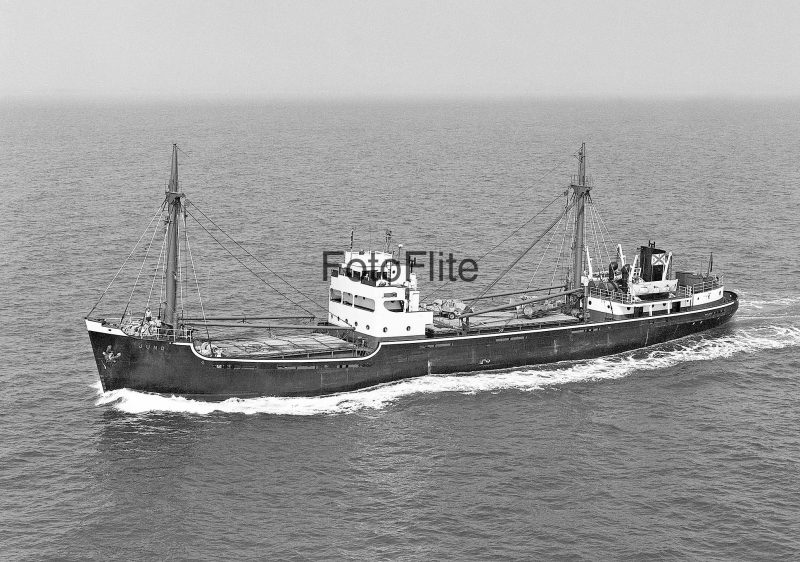
Cato became an early war loss on 3rd March 1940 when she was sunk by striking a mine laid by U29 2.5 miles west of Nash Point in the Bristol Channel, unfortunately her Master and twelve others were drowned with only two survivors. She carried a big cargo of 740 barrels of beer and Guinness stout. Melito survived the war to sail on until 1950 when she was sold to Fairwood Shipping Ltd. and renamed Fairwood Oak, becoming Holdervale for the Holderness Steamship Company in 1956 and then arrived for breaking up at Charleston in Fife on 19th May 1957.
Capito was under the command of Capt. E. Moodie with Harry Tucker as First Mate when she dragged her anchors and grounded on Hare Island in Galway Bay in 1941. She was carrying sulphate of ammonia and was lucky to be refloated to sail on after the end of the war until sold in 1950 and renamed Neree for two further years until broken up at Grays in Essex in November 1952. Coast Lines had made an unsuccessful bid for the company in the early part of the war, but the company preferred to remain independent with its strong Irish and Continental services including calls at Gloucester Docks with sugar beet.
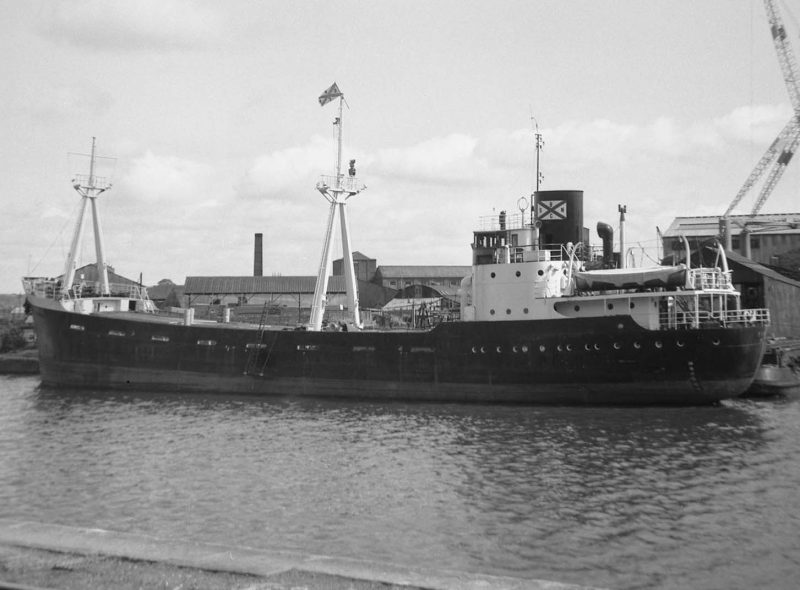
Post-War Years
In post-war years, the Albion shipyard of Charles Hill & Sons Ltd. resuming building for the company with six coasters named Juno 969/49, Pluto 988/50, Milo 991/53, Apollo 1,230/54, Echo 1,148/57, Hero 1,564/63, and followed by Dido 1,569/63 from the Waterhuizen yard of J. Pattje. However, the first pair of newly built ships had been ordered in 1943 and appeared in 1946 from the Goole Shipbuilding and Repairing yard as Cato and Ino of 1,122 dwt. They had their navigating bridges ‘midships, engines aft, and two masts with four derricks for working cargo. Ino had a career of only eight years with the company, as she was sold to the Adelaide Steamship Co. Ltd. of Melbourne and renamed Maltara for Australian coastal trading. She then moved up to Hong Kong in 1967 as Sandy, and then gained metal shutters over her accommodation in 1974 for her crew to cope with the heat of Singapore when renamed Bagas, before finally being broken up in May 1984 at Tandjung Priok. Cato ran down and sank her tug, Sea Prince of C. J. King, in 1957 whilst entering the Avon, and was herself rammed and sunk by the Ellerman cargo-liner City of Brooklyn on 24th April 1963 while berthed at Avonmouth. She was sliced in two at the after end of number two hatch and sank, and was raised and sold for breaking up a month later at Newport.
The fleet was composed of six coasters in 1950, with the new motorship sisters Juno and Pluto of 1,332 dwt, the 1946 sisters Cato and Ino, and two old steam coasters in Capito and Melito, both sold off later that year. Juno sailed for the company for eighteen years until sold in 1967 to Greek owners as Enarxis, but was aground at the end of the following year at St. Jean de Luz whilst on a voyage from Bayonne to Leith with maize and became a constructive total loss, fit only for scrapping at Bilbao. Pluto was sold and renamed Dino in 1967 but sank off Cape Teulada at the southern tip of Sardinia on 9th April 1973 while coasting from Italy with a cargo of clay.
The bridge ‘midships engines aft steam coaster Sussex Elm was purchased in July 1951 and renamed Sappho. She had been completed in May 1923 without a name and laid up by the Hansen Shipbuilding yard at Bideford, but began her career as Monkstone in 1924, becoming Sussex Elm in 1946. She was sold by the company in June 1953 to the Williamstown Shipping Co. Ltd. (Comben Longstaff & Co. Ltd., manager), but was wrecked on 4th February 1954 four miles south of Aldeburgh while on a voyage from Ipswich to Goole in ballast. The similar quarterdecker steam coaster Porthmeor of 752 grt was purchased in 1951 and renamed Apollo, and had been built as Goodig in 1919 by the Forth Shipbuilding and Engineering yard for Stone and Rolfe Ltd. of Llanelly. She was sold in early 1954 and renamed Carbis Bay and arrived for breaking up at Blyth on 2nd August 1956.
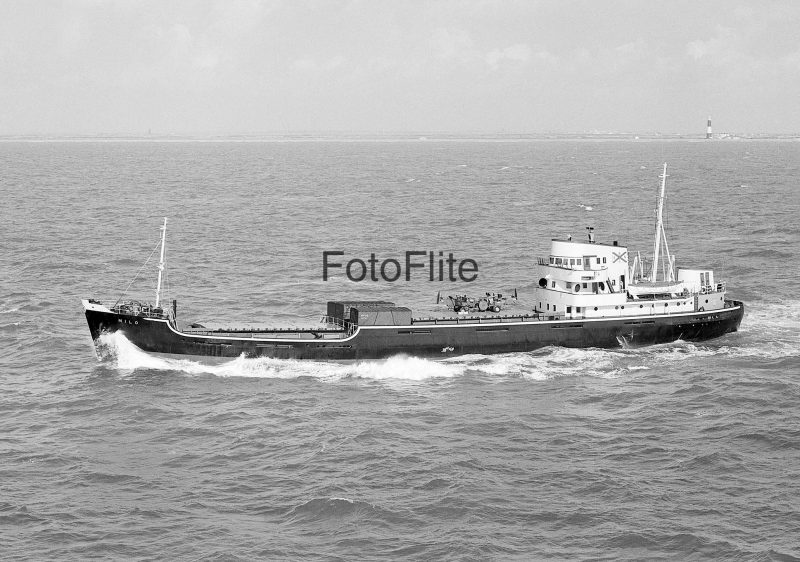
Milo of 1953 of 1,360 dwt had bridge and engines aft and was given a ‘wraparound’ curved bridge and funnel, and was used on both the Irish and Continental services including to Bordeaux for wine. She was sold to J. & A. Gardner & Co. Ltd. in 1969 and renamed Saint Angus, but suffered a fire in her accommodation off Coquet Island near Amble on 21st July 1975 and was towed down to the Tyne for repair. She was sold after repair and renamed Lady Maria but was wrecked off the Somali Coast on 18th August 1976.
Apollo and Echo of 1,480 dwt, were sisters dating from 1954 and 1957, again with ‘wraparound’ curved bridge and funnel and without cargo gear above their three hatches, and were powered by eight cylinder British Polar diesels of 1,250 bhp to give service speeds of 12.5 knots. This pair were lengthened by seven metres in 1968/69 and converted to container ships of 75 TEU capacity with a Liebherr gantry, and sailed on for the company from 1971 until it went out of existence in 1980. Echo went to Greeks in 1980 as Ageliki III and after a further eight changes of name was broken up at Gadani Beach in August 2000. Apollo was sold in 1980 and renamed Clan Rose, and then traded around Guyana as Paulemose R.
The final new Bristol Steam Navigation Company coasters were Hero of 1,825 dwt and Dido of 1,995 dwt when completed at Hotwells and Waterhuizen in 1963 to give the company a modern fleet of eight motor vessels. Hero was sold to S.W. Coe of Liverpool in 1970 and converted in 1975 into a drillship with a drilling platform and mooring anchors on charter to the National Environment Research Council. She continued after sale by Coe as a drillship until she was broken up at Gadani Beach in November 2002. Dido from the J. Pattije yard at Waterhuizen was sold to Coe in 1977 for conversion into a geophysical survey ship but was laid up in Vittoria Dock at Birkenhead in 1982. She was converted in 1990 into a radio ship named Deese de la Democratie, but was arrested in Taiwan and broken up there in September 2003.
One purchased coaster in the post-war fleet was Sappho, built in 1949 at Goole as Falster for Ferm A/B of Kristinehamn (T.E. Brostrom) of Sweden. She was powered by a five cylinder Atlas diesel with a service speed of eleven knots, and had been completed with a set of derricks for cargo handling. These were later removed, and when purchased by the company in 1960 she still had her magnetic compass, no gyro compass, on her monkey island viewed through a periscope in front of the helmsman in the wheelhouse below. She loaded coal in South Wales ports for the Continental runs, and had various escapades including groundings in Continental ports and broaching near the Lizard after being hit by mountainous seas. She was sold in the late 1960s when the company fleet was drastically reduced in size, and was broken up in 1975/76.
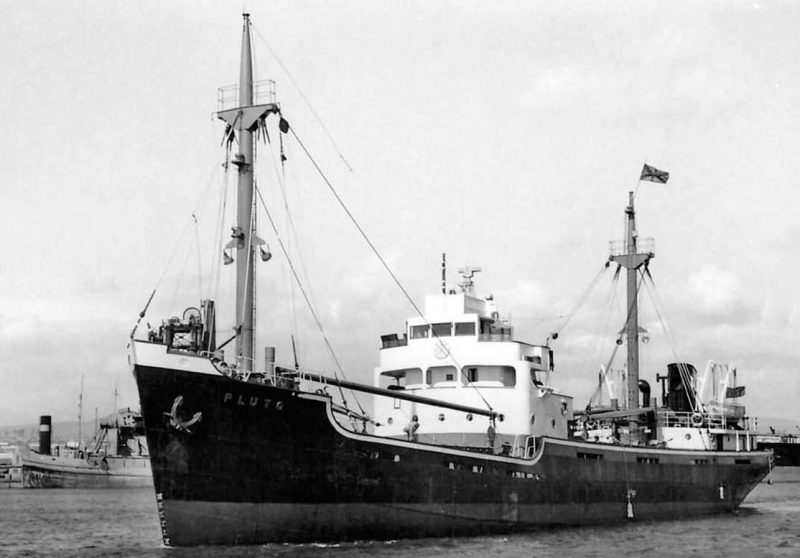
In 1969, the company moved from Bristol Docks down the Avon to Avonmouth Docks, and the smart black hulls with red boot topping, and black funnels with the white houseflag and red cross with ‘B’, ‘S’, ‘N’ and ‘Co’ in blue in the four white quarters, were seen no more in Bristol. The company spent £750,000 in 1969 to modernise the fleet and provide Liebherr roaming gantry cranes at Avonmouth and Dublin. Douglas Lovell, Chairman and Managing Director of the company, set up a committee to carry this through. Apollo was sent to a Rotterdam shipyard to be converted to carry 72 TEU of containers, and was lengthened by 24 feet, and her ‘tween deck and main deck hatch covers were replaced by new hydraulically controlled hatch covers especially designed for container carrying. By a slight modification to the design, sister Echo was able to carry 75 TEU of containers. The pair made four round voyages per week instead of three prior to modernisation and carried containers, flats and Guinness tanks.
In the 1970s, Bristol Steam Navigation Company and Bristol Seaway Ltd. and the Irish services of Seawheel Ltd. amalgamated under the name of Bristol Seaway, with much greater container throughput provided by Seawheel Ltd. The staff of the Irish Department and Continental Department of the company that completed ship’s reports and clearances on arrivals and departures had to change their procedures after the implementation of container carrying.
The converted container ship sisters Echo and Apollo, dating from 1954 and 1957, carried on in the Dublin trade to become the final two coasters in the fleet in the late 1970s, with one on charter on the East Coast. Funnel colours were now yellow with ‘B’, ‘S’, ‘N’, ‘Co’ in blue on the quarters of the houseflag, reflecting the influence of the Lovell’s Shipping and Trading Group Ltd. In 1980, the pair of coasters were quickly sold on to foreign buyers. The time spent at sea by their crews per week had not been long, and as low as 48 hours per week on the Irish run by Capt. Jenkins of Echo. However, the other Masters on the Continental run to Antwerp, Amsterdam and Rotterdam or Bordeaux spent more time at sea with more ports of call. When Bristol Steam Navigation Company ceased operations in 1980, the Lovell family continued some of their shipping activities, with their Greenwich Wharf using two Butters cranes brought from Dublin in Bristol Seaway vessels. In 1982, Lovell’s Wharf at Greenwich handled 118,000 tonnes of cargo including steel, aluminium, galvanised sheeting, gas pipes, timber and general cargo, but the wharf became disused in the 1990s.
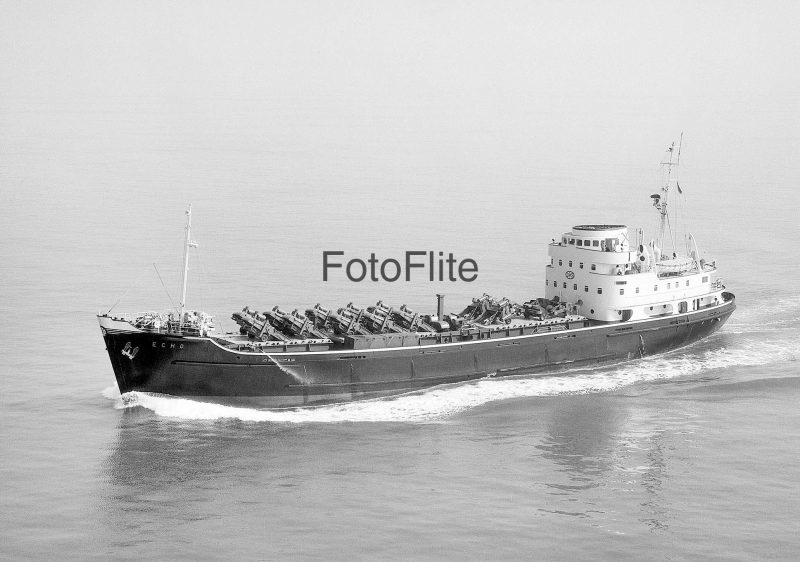
Postscript
Bristol Steam Navigation Company outlasted almost all other British coastal liner companies, including the empire of Coast Lines, taken over in February 1971 by the P. & O. Steam Navigation Co. Ltd. for £5.6 million. Coast Lines had itself taken over dozens of British coastal liner companies between its formation in 1913, when three such coastal liner companies merged together, and the takeover in 1971. The takeover made sense from the P. & O. perspective, as it joined the Irish Sea services of the company to the already controlled Thames, East Coast and Continental services of the General Steam Navigation Co. Ltd., fully P. & O. controlled since 1920.
Fellow Bristolians P. & A. Campbell finally folded in 1979 after 125 years in business, being founded in 1854 on the Clyde and moving south to Bristol in 1888. Their last and famous Bristol Channel paddlers Bristol Queen and Cardiff Queen were withdrawn from service in 1967 and 1968 respectively, and the company thereafter used the motorships Balmoral of 1946 and Devonia of 1955 for their Bristol Channel excursions. Another vessel used was the twin funnelled St. Trillo, completed in 1936 as St. Silio, which was purchased in February 1963 from the Liverpool and North Wales Steamship Company, founded in 1890 for excursions to Llandudno and North Wales from Liverpool. The Liverpool company had gone into voluntary liquidation at the end of the 1962 excursion season, with the receiver immediately selling St. Seiriol for breaking up in November 1962 followed by St. Tudno in April 1963. P. & A. Campbell used St. Trillo for North Wales excursions until the early 1970s and then also used her on the Bristol Channel. The Head Office of the Liverpool excursion company at 40, Chapel Street in Liverpool had been demolished in December 1970.
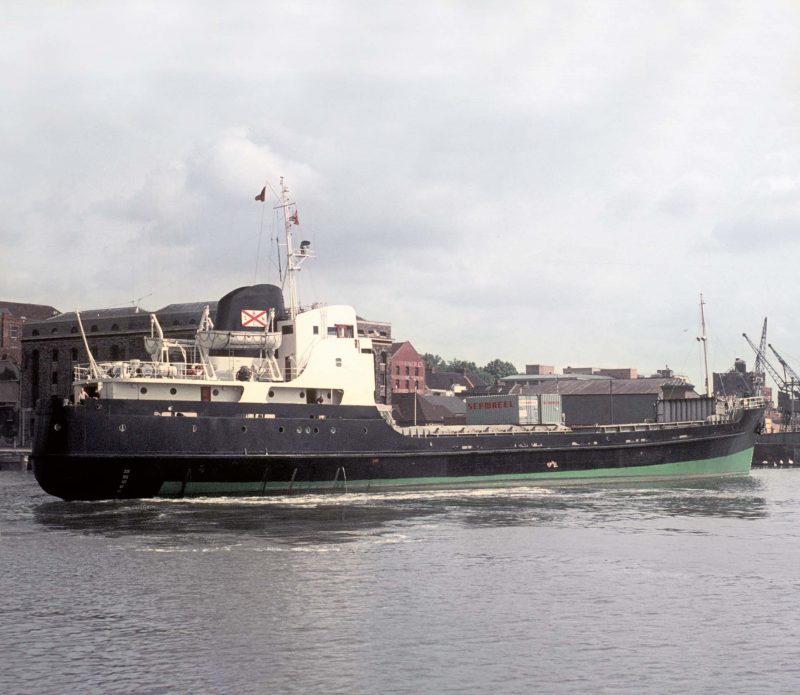
It was the same story on the North Sea, with Ellerman’s Wilson Line folding around the same time as the Bristol Steam Navigation Company, finally ceasing operations in 1981 after 150 years in business. The original Wilson Line, founded by Thomas Wilson in 1831, had been taken over by Sir John Ellerman in 1916 and was renamed Ellerman’s Wilson Line. The Hull to Gothenburg luxurious passenger motor vessel Spero of 6,916 grt was built in 1966 by Cammell, Laird at Birkenhead with accommodation for 408 one class passengers, and ran until sold on 1st May 1973 to Maritime Lines of Lesvos in Greece for the England Sweden Line (ESL) in a consortium with Swedish Lloyd and Svea Line. Their last ships were the ro-ros Destro and Domino of 2,850 dwt from the Ankerlokken Verft yard in 1970 and sold in 1978 to Italian owners, and the ro-ro Hero of 3,600 dwt from the Robb Caledon Ltd. yard at Leith in 1972 and lost in the North Sea on 13th November 1977. Finally, two ro-ros of 7,500 dwt from the South Bank yard of Smith’s Dock, Cicero and Cavallo, encountered major problems at the yard of late delivery and malfunction of their main internal cargo lifts, incurring late penalties and non delivery of Cavallo, which remained laid up at the yard until sold in 1981. They were actually registered under Ellerman Lines and in 1988, they were both sold to the Clarke Transportation Co. Ltd. of St. John’s (NFL) in Canada.
Clarke also had a long shipowning history dating back to 1921 when the Clarke Steamship Company was founded with a Head Office in Quebec to initially run two passenger services from Quebec to Bradore Bay on the North Shore and from Quebec to Gaspe on the South Shore of the St. Lawrence. Larger three funnelled passenger liners from the late 1920s cruised to the beautiful Saguenay River and Murray Bay, and in summer moved south to Miami to cruise to the tropical Bahamas.
I lived and worked in Bristol from 1966 to 1971, and used to walk down to Bristol Docks across Clifton Down or Whiteladies Road, but after 1969 Bristol Docks became mostly deserted. The fleet was always well maintained and ‘Shipshape and Bristol Fashion’, and the Masters and crews took a pride in their appearance when sailing to the many Continental and Irish ports that the Bristol Steam Navigation Company served so well for 160 years.
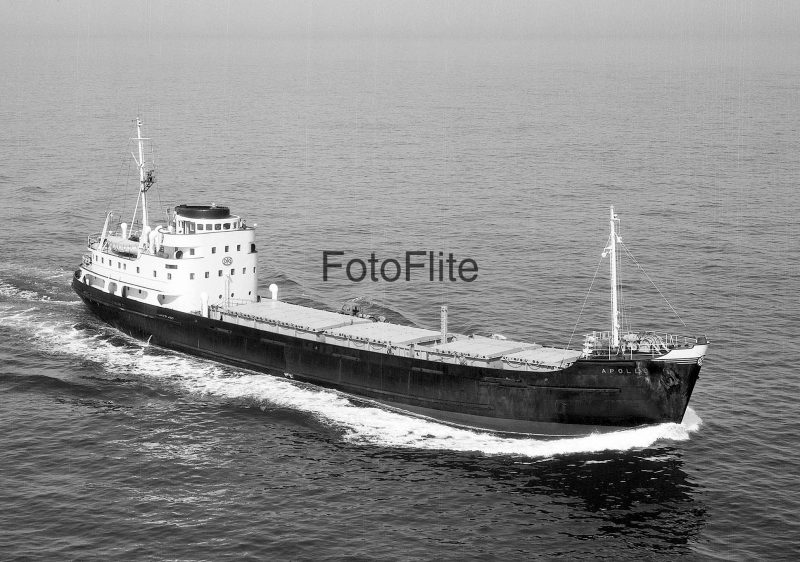
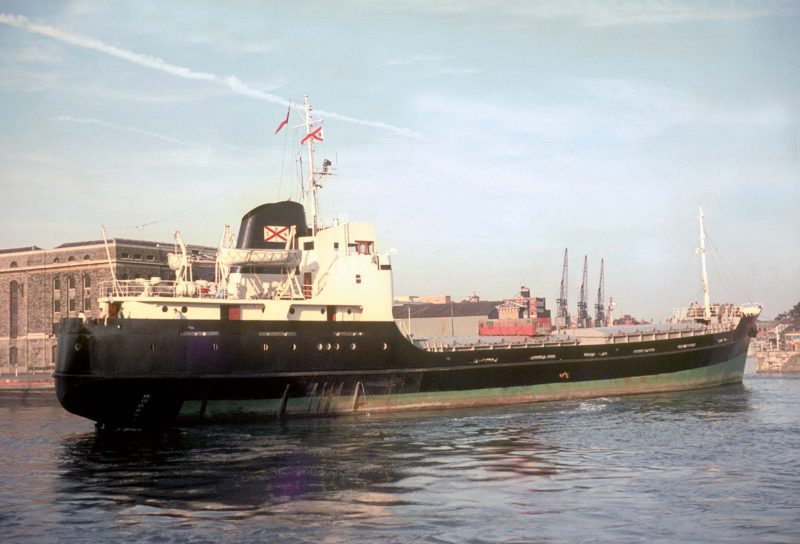

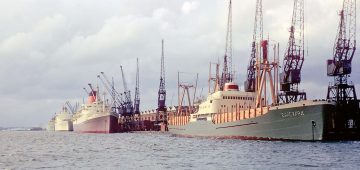



Comments
Sorry, comments are closed for this item